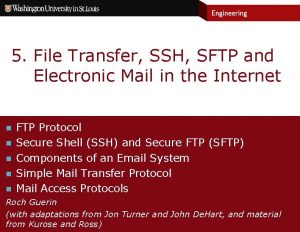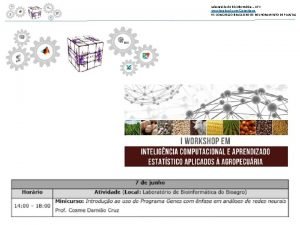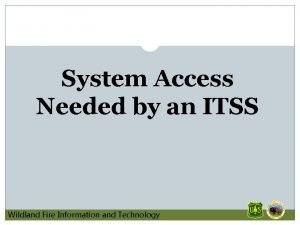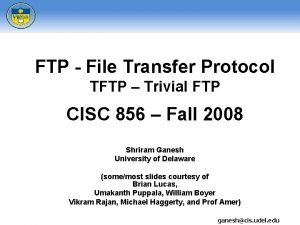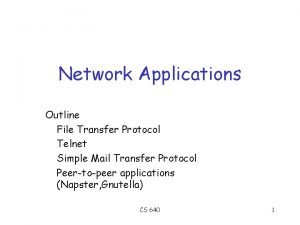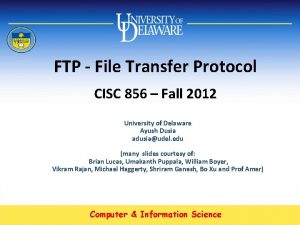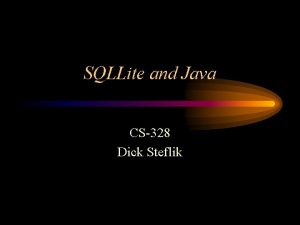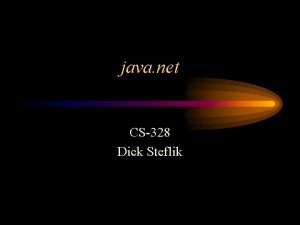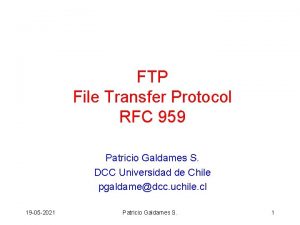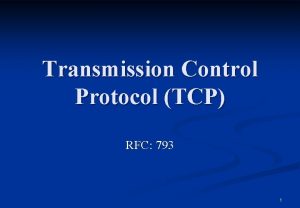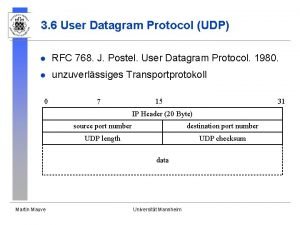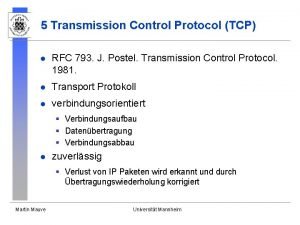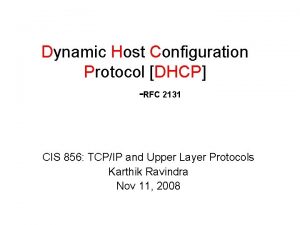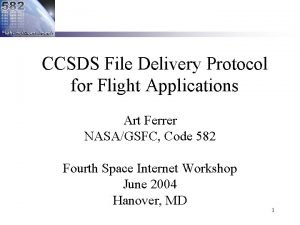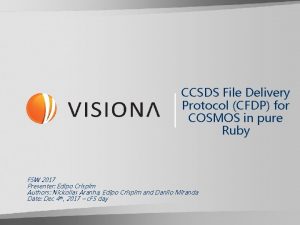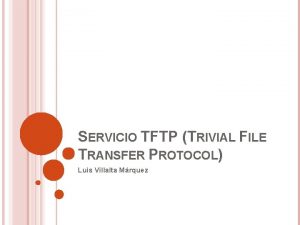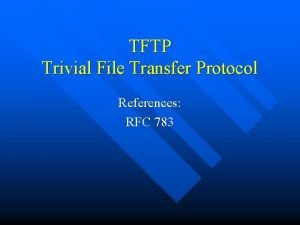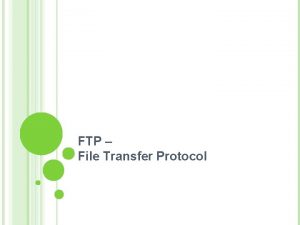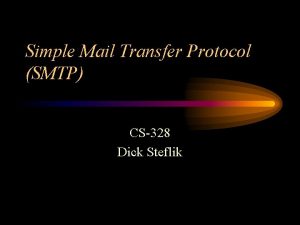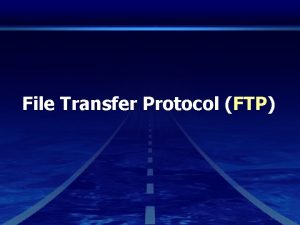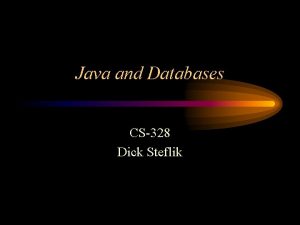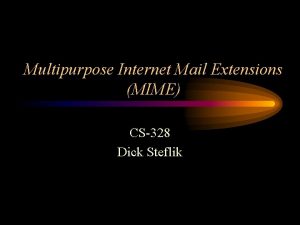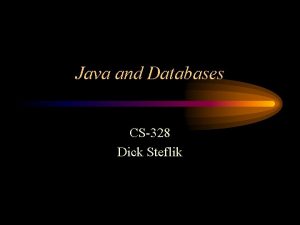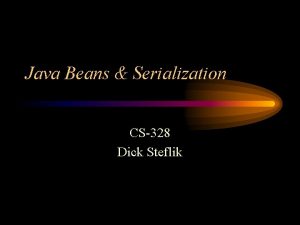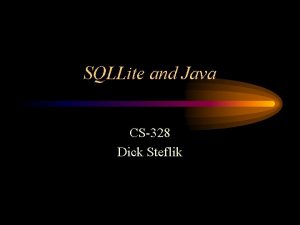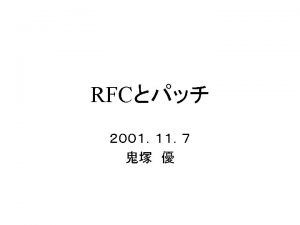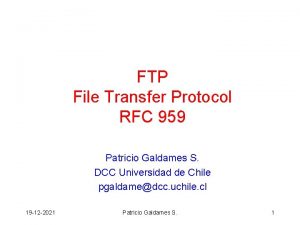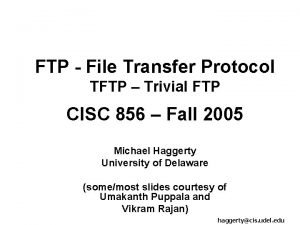File Transfer Protocol CS328 Dick Steflik FTP RFC




















- Slides: 20

File Transfer Protocol CS-328 Dick Steflik

FTP • RFC 959 • uses two TCP Ports – one for control – one for data transfers • command-response protocol • control port uses telnet protocol to negotiate session – US-ASCII – <crlf> is end-of-line character

Active Mode FTP • Client connect from a random unprivileged port (n > 1023) to the servers command port (21) and sends port command to tell server to connect to n+1 then listens on the next higher unprivileged port (n+1) for server responses. The server connects from it’s data port (20) to the client data port (n+1) Server 20 Client 21 1026 1 2 3 4 1027

Passive Mode FTP • Client opens two random unprivileged ports ( n > 1023 and n+1; ex 1026 and 1027) and connects the first port (n) to server command port 21 and issues a pasv command (server sends port to use for data); client connects to servers specified data port, server completes connection. Server 20 2024 Client 21 1026 1 2 3 4 1027

Transfer Files in a Heterogeneous Host Environment • Due to multiple hardware types and operating systems file are converted to four environmentally neutral data type for transport and the converted to local types at the destination – – ASCII EBCDIC IMAGE LOCAL A E I L NVT-ASCII EBCDIC Text Raw binary, series of octets Raw binary using a variable byte size • Client responsibility to tell server data type to use • Default data type, unless otherwise specified is ASCII

File Structures • Operating System store files in different structures • FTP defined file structures for transporting files – File – Record – Page F R P Unstructured, sequence of bytes Series of records Series of data blocks (pages) • Default file structure is File (F) • File Structure specified using STRU command

Transmission Modes • Mode is used to specify additional coding or sequencing performed on data • independent of data type and file structure – Stream S – Block B – Compressed C stream of bytes, if record structure EOF sent as record indication; if file eof indicated by closing stream file sent as sequence of blocks preceded by header info allows restart of an interruped transfer data compressed using run length encoding

FTP Commands • • • USER PASS ACCT CWD CDUP SMNT QUIT REIN PORT R O O O R User name, userid for access control Password for access control Account info Change working directory Change to parent directory Structure mount, mount a different file system informs server that client wants out restarts session at authentication phase Host addr and data port to use

FTP Commands (more) • PASV O Passive; informs server that client will contact to set up data connections, ask server to sent port info • TYPE R Data type, type of subsequent transfers • STRU R File structure • MODE R Transfer mode • RETR R Retrieve, download the file from server • STOR R Store, upload the specified to server • STOU O Store unique, same as store but server picks unique file name

FTP Commands (more) • APPE O Append, upload file to server, if file name exists, append the upload • ALLO O Allocate, sometimes used to preallocate space • REST O Restart, restart an interrupted transfer • RNFR O Rename file from filename • RNTO O Rename file to • ABOR O Abort, ask server to abort last command • DELE O Delete specified file • RMD O Remove directory • MKD O Make directory

FTP Commands (more) • • PWD LIST NLST SITE O O • • SYST STAT HELP NOOP O O O R Print working directory Request directory listing Request just a file name list Site parameters, allow client to specify site specific options and parameters request server operating system Request server to send status of current xfr general and command specific ask server to send a positive reply

FTP Responses • Each command generates a server response – 3 digit code, text, <crlf> • use 3 digit code as driver for GUI Clients or programatic implementations • use text for Command line clients

Responses • 1 yz - Positive preliminary reply - command is being acted upon; expect a final reply code before sending another command • 2 yz - Positive completion reply - command was successfully executed; new command may be sent • 3 yz - Positive intermediate reply - command was accepted, but the final result is being delayed because other information needs to be supplied from the client; reply is used for sequencing command groups • 4 yz - Transient negative completion reply - command failed, but the condition is temporary • 5 yz - Permanent negative completion reply - command failed and will always fail if given again; the command should not be attempted again

Response • x 0 z - Refers to command syntax • x 1 z - Indicates information returned by commands requesting information such as status or help • x 2 z - Refers to the state of the control or data connections • x 3 z - The reply is associated with the login process and accounting procedures • x 4 z - Reserved for future use • x 5 z - Refers to the state of the requested file transfer or other file system command

Trivial File Transfer Protocol • RFC 1782 • UDP port 69 • Simple protocol, usually used to transfer configuration files • Usually used for transferring boot file for diskless hosts (X-Stations) or updating NVRAM

TFTP • Typically used in short distance, low noise environments • Server is usually implement in firmware for updating things like routers, bios. . .

TFTP • Because of its compact size: – no error recovery like TCP based FTP – no command structure like FTP – cannot list directories – transfers to server are to a single configured directory

Transfer Modes • netascii (8 -bit ASCII) • raw binary • mail (obsolete, not used)

TFTP Transfers • • client send a RRQ or WRQ to server sends ACK 0 client sends DAT 1 repeat until done

TFTP Formats • Type Op # Format without header 2 bytes string 1 byte ---------------------------RRQ/ | 01/02 | Filename | 0 | Mode | 0 | WRQ ---------------------------2 bytes n bytes ----------------DATA | 03 | Block # | Data | ----------------2 bytes --------------ACK | 04 | Block # | --------------2 bytes string 1 byte --------------------------ERROR | 05 | Error. Code | Err. Msg | 0 | ---------------------------
 Ssh file transfer protocol rfc
Ssh file transfer protocol rfc File transfer cbre
File transfer cbre Mathew garber
Mathew garber Ftp://ftp.ufv.br/dbg/biodata/
Ftp://ftp.ufv.br/dbg/biodata/ Ftp wildland fire
Ftp wildland fire File transfer protocol purpose
File transfer protocol purpose File transfer telnet
File transfer telnet Purpose of ftp protocol
Purpose of ftp protocol File-file yang dibuat oleh user pada jenis file di linux
File-file yang dibuat oleh user pada jenis file di linux Cs328
Cs328 Cs328
Cs328 Patricio galdames
Patricio galdames File sender uga
File sender uga Bitsnn
Bitsnn Udp header
Udp header Sliding window tcp
Sliding window tcp Dhcp message flow
Dhcp message flow Ccsds file delivery protocol
Ccsds file delivery protocol Ccsds file delivery protocol
Ccsds file delivery protocol Trivial flag transfer protocol
Trivial flag transfer protocol Rfc 783
Rfc 783
